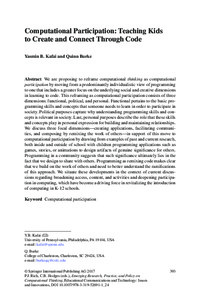Computational ParticipationTeaching Kids to Create and Connect Through Code
Publikationsdatum:
Zu finden in: Emerging Research, Practice, and Policy on Computational Thinking (Seite 393 bis 405), 2017
  |
 |
 Diese Seite wurde seit 2 Jahren inhaltlich nicht mehr aktualisiert.
Unter Umständen ist sie nicht mehr aktuell.
Diese Seite wurde seit 2 Jahren inhaltlich nicht mehr aktualisiert.
Unter Umständen ist sie nicht mehr aktuell.
 Zusammenfassungen
Zusammenfassungen
 Die Autorinnen sehen computational participation als eine Erweiterung von computational thinking u.a. weil heute in Gruppen und nicht mehr alleine programmiert wird und weil heute nicht mehr auf der grünen Wiese bzw. mit dem leeren Bildschirm, sondern aufbauend auf bisherigen Programmen / Bibliotheken programmiert wird.
Die Autorinnen sehen computational participation als eine Erweiterung von computational thinking u.a. weil heute in Gruppen und nicht mehr alleine programmiert wird und weil heute nicht mehr auf der grünen Wiese bzw. mit dem leeren Bildschirm, sondern aufbauend auf bisherigen Programmen / Bibliotheken programmiert wird.
We are proposing to reframe computational thinking as computational participation by moving from a predominantly individualistic view of programming to one that includes a greater focus on the underlying social and creative dimensions in learning to code. This reframing as computational participation consists of three dimensions: functional, political, and personal. Functional pertains to the basic programming skills and concepts that someone needs to learn in order to participate in society. Political purposes capture why understanding programming skills and concepts is relevant in society. Last, personal purposes describe the role that these skills and concepts play in personal expression for building and maintaining relationships. We discuss three focal dimensions—creating applications, facilitating communities, and composing by remixing the work of others—in support of this move to computational participation by drawing from examples of past and current research, both inside and outside of school with children programming applications such as games, stories, or animations to design artifacts of genuine significance for others. Programming in a community suggests that such significance ultimately lies in the fact that we design to share with others. Programming as remixing code makes clear that we build on the work of others and need to better understand the ramifications of this approach. We situate these developments in the context of current discussions regarding broadening access, content, and activities and deepening participation in computing, which have become a driving force in revitalizing the introduction of computing in K-12 schools.
 Dieses Kapitel erwähnt ...
Dieses Kapitel erwähnt ...
 Personen KB IB clear | William Aspray , Yochai Benkler , Karen Brennan , Quinn Burke , Robbin N. Chapman , Katie Clinton , J. McGrath Cohoon , Evelyn Eastmond , Deborah A. Fields , Michael Giang , Idit Harel , Henry Jenkins , Yasmin B. Kafai , Caitlin Kelleher , John Maloney , Amon Millner , Andrés Monroy-Hernández , Seymour Papert , Randy Pausch , Kylie A. Peppler , Ravi Purushotma , Mitchel Resnick , Alice J. Robison , Eric Rosenbaum , Natalie Rusk , Jay Silver , Brian Silverman , Margaret Weigel , Jeannette M. Wing | ||||||||||||||||||||||||||||||||||||||||||||||||||||||||||||||||||||||||||||||||||||||||||||||||||||||||||||||||||||||||||||||
 Begriffe KB IB clear | AgentSheets
, CommunityCommunity
, computational participation
, computational thinkingcomputational thinking
,  Kinder Kinder children
, children
,  Programmieren Programmieren programming
, Programmieren für KinderProgramming for kids
, programming
, Programmieren für KinderProgramming for kids
,  Scratch Scratch
| ||||||||||||||||||||||||||||||||||||||||||||||||||||||||||||||||||||||||||||||||||||||||||||||||||||||||||||||||||||||||||||||
 Bücher |
| ||||||||||||||||||||||||||||||||||||||||||||||||||||||||||||||||||||||||||||||||||||||||||||||||||||||||||||||||||||||||||||||
 Texte |
|
 Dieses Kapitel erwähnt vermutlich nicht ...
Dieses Kapitel erwähnt vermutlich nicht ... 
 Nicht erwähnte Begriffe | AgentCubes, Eltern |
 Tagcloud
Tagcloud
 Zitationsgraph
Zitationsgraph
 Zitationsgraph (Beta-Test mit vis.js)
Zitationsgraph (Beta-Test mit vis.js)
 Zeitleiste
Zeitleiste
 4 Erwähnungen
4 Erwähnungen 
- Second Handbook of Information Technology in Primary and Secondary Education (Joke Voogt, Gerald Knezek, Rhonda Christensen, Kwok-Wing Lai) (2018)


- Programmieren in der Grundschule - Eine Design-Based-Research-Studie (Katharina Geldreich) (2023)


- Past, Present and Future of Computing Education Research (Mikko Apiola, Sonsoles López-Pernas, Mohammed Saqr) (2023)


- Computing Education Research in Baltic Countries (Valentina Dagienė, Mart Laanpere, Juris Borzovs)


- Computing Education Research in Baltic Countries (Valentina Dagienė, Mart Laanpere, Juris Borzovs)
 Anderswo finden
Anderswo finden
 Volltext dieses Dokuments
Volltext dieses Dokuments
 |  Computational Participation: Teaching Kids to Create and Connect Through Code: Artikel als Volltext bei Springerlink ( Computational Participation: Teaching Kids to Create and Connect Through Code: Artikel als Volltext bei Springerlink ( : :  , 211 kByte; , 211 kByte;  : :  ) ) |
 Anderswo suchen
Anderswo suchen 
 Beat und dieses Kapitel
Beat und dieses Kapitel
Beat hat Dieses Kapitel während seiner Zeit am Institut für Medien und Schule (IMS) ins Biblionetz aufgenommen. Beat besitzt kein physisches, aber ein digitales Exemplar. Eine digitale Version ist auf dem Internet verfügbar (s.o.). Es gibt bisher nur wenige Objekte im Biblionetz, die dieses Werk zitieren.




























 Biblionetz-History
Biblionetz-History